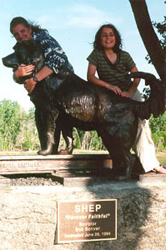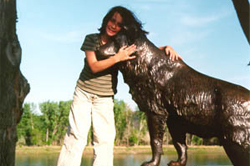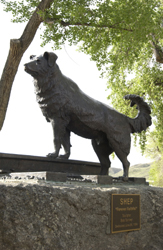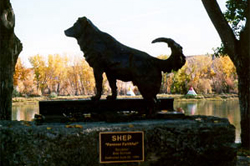The Story of Shep
Updated: September 2, 2020

As the population of the United States moved west in the late 19th and early 20th century large flocks of sheep and cattle followed the expansion. When gold was discovered, prospectors quickly depleted the local food supplies. Meat was needed to supply the gold camps. Sheep were brought West to help fill the need. It was said that it took seven mounted men to move 1,000 head of cattle; a single herdsman with one good dog could drive the same number of sheep.
A special breed of working dog, originally descendent from the pastoral dogs the Romans brought to England, helped move the large flocks of sheep over the Great Plains. Most were English Shepherds or Border Collies. They were used to gather and protect the herds' that grazed in the high country and open ranges of the west. The dogs were intelligent and independent. They could travel great distances to gather the scattered flocks, often far away from their handlers. The dogs were calm, steady, willing to please, and could be used to herd any type of livestock. Perhaps the most significant trait was the dog's bond with its owner. It was a lucky sheepherder that had a good dog for his best friend in the remote high country of Montana.

One such dog lived near the birthplace of the Montana, Fort Benton. During the summer of 1936 a sheepherder fell ill while tending his flock and was brought to St. Clare Hospital. A nondescript sheep dog followed the herder into town and soon set up a vigil at the hospital's door. A kind-hearted nun who ran the hospital kitchen fed the dog during those few days before the man died. The herder's family in the East requested that his body be sent back home. On that August day the undertaker put the body on the eastbound train for shipment to his waiting relatives. As the gurney was rolled out onto the platform the gaunt sheep dog appeared out of nowhere and watched anxiously as the casket was loaded into the baggage car. Attendants recalled the dog whining as the door slammed shut and the engine slowly started to pull away from the station. Head down, he turned and trotted down the tracks. On that day the dog, later named Shep, began a five-and-one-half year vigil that was only broken by his death.
Day after day Shep met all four scheduled passenger trains and became a fixture on the platform. Ever hopeful he eyed each arriving passenger, waiting for the return of his master. Shep was often chased off as a mongrel but he never broke his watch. Neither the heat of summer days nor the bitter Montana winter days prevented Shep from meeting the next train.

As Shep's fame spread, people came from everywhere to see him, to photograph him, and to try and make friends and possibly adopt him. All of the attention was somewhat unwelcome; after checking the train he often retired quickly to get away from those who came to see him. Shep was a one-man dog. The bond he had formed with the herder many years before was simply the most important thing is his life. The railroad employees now provided food, shelter, and care. That was all he required, except his master's return.
Shep was not a young dog when he began his vigil and the long nights under the platform, at the Station House, and the cold winters had taken their toll. Stiff-legged and hard of hearing, Shep failed to hear engine number 235 as it rolled into the station that cold winter morning at 10:17. He turned to look when the engine was almost upon him, moved to get out of the way, and slipped on the icy rails. Shep's long watch had ended.
Shep's funeral was held two days later. He was buried on the bluff overlooking the station where his vigil had been in vain. The sights and sounds of the singing rails and the whistles around the bend are all gone now. No passenger trains serve Fort Benton today, but Shep still maintains his lonely vigil atop the wind-swept bluff overlooking the abandoned depot.

With renewed interest generated by the fiftieth anniversary of Shep's death, the community of Fort Benton organized a committee to produce a lasting memorial to their famous dog. One of the West's most renown sculptors, Bob Scriver, was contracted to create a heroic-sized bronze statue of Shep. Using photographs and a Shep "look-alike," Scriver developed a stirring resemblance to the admirable dog. He stands expectantly with ears cocked, tail up, and his two front paws on the rail. He gazes longingly down the track forever awaiting his master's return.
A beautiful site along the levee of the Missouri River was selected for the memorial. Located in the park across from the Grand Union Hotel along Front Street, Shepherd's Court quickly became the town's focal point. The large bronze statue was placed on rough granite stone from a local quarry. The stone is low enough to permit even the smallest child to stand beside the faithful dog - for petting and pictures. The statue is a fitting tribute to the devotion of man's best friend, and a reminder of the wonderful story of Shep, Forever Faithful.
Updated: September 2, 2020

